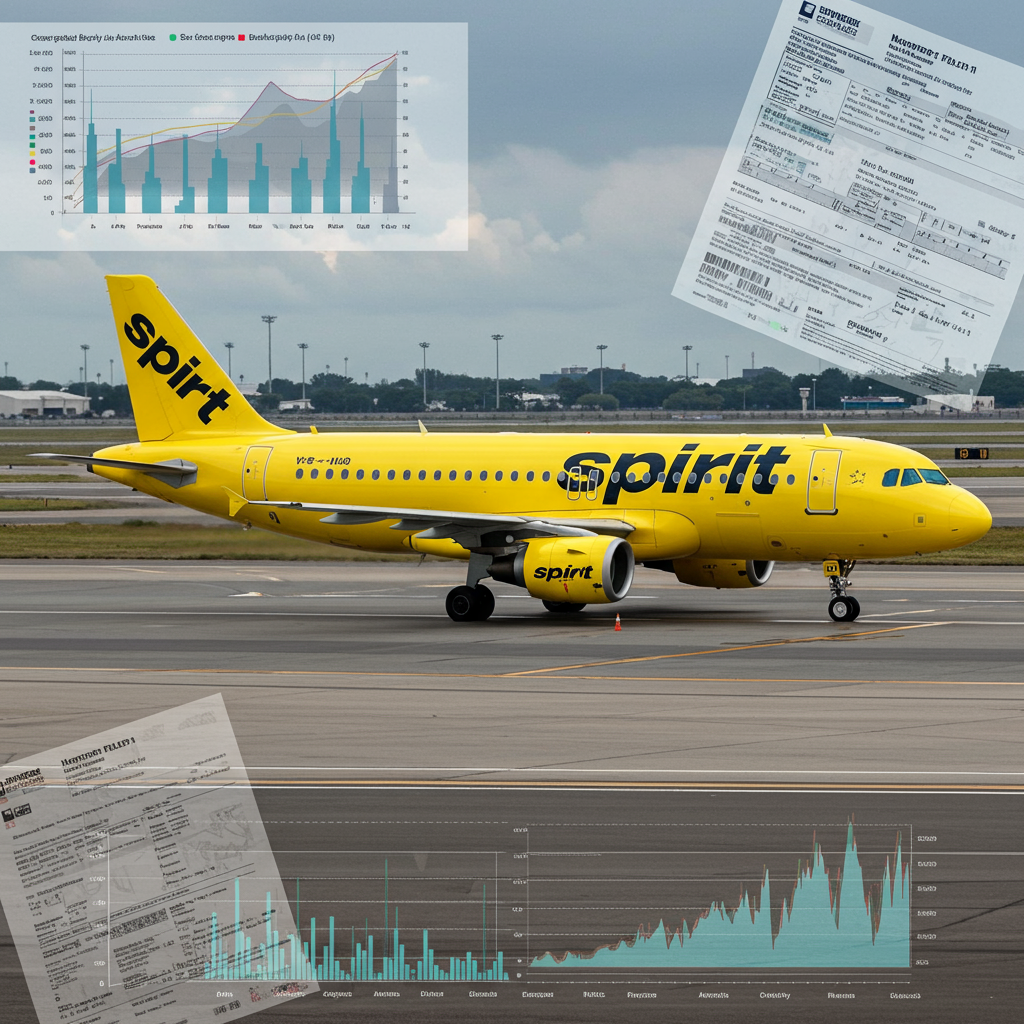The aviation world is once again buzzing with significant news for budget travelers: Spirit Airlines has filed for Chapter 11 bankruptcy protection for a second time in less than a year. This latest filing, coming mere months after its previous emergence from reorganization in March, signals profound financial distress for the nation’s largest ultra-low-cost carrier. For passengers, employees, and the broader airline industry, this development raises critical questions about the future of affordable air travel and Spirit’s ability to navigate turbulent skies.
Spirit’s Repeated Plunge: A Second Chance Squandered?
Spirit Airlines’ latest move into bankruptcy protection underscores the deep-seated challenges it faces. The carrier had hoped its initial Chapter 11 filing in November would pave the way for a stronger future. That prior restructuring primarily focused on reducing its substantial funded debt and raising equity capital. However, it notably avoided more drastic operational changes, such as significantly shrinking its fleet or network.
Spirit CEO Dave Davis acknowledged this in a recent statement. He indicated that while the first restructuring was aimed at debt and capital, “much more work” and “many more tools” are clearly needed to properly position the airline for the future. Indeed, the earlier efforts proved insufficient, leaving the airline vulnerable to “adverse market conditions” and ongoing “uncertainties in its business operations,” expected to persist through at least 2025.
The Costly Aftermath: Financial Fallout
The financial picture painted by Spirit Airlines is stark. Despite a December forecast projecting a net profit of $252 million for the current year, the airline instead reported a staggering net loss of nearly $257 million since March 13, its emergence from the first Chapter 11, through the end of June. This dramatic reversal led the parent company, Spirit Aviation Holdings, to express “substantial doubt” about its ability to continue as a “going concern” over the next year – a critical accounting term indicating a severe lack of funds.
The airline’s stock performance mirrored this crisis. Spirit’s shares plummeted by 72% over the past month and saw an additional 45% drop in after-hours trading following the second bankruptcy announcement. This reflects intense investor concern about the carrier’s long-term viability and the effectiveness of its restructuring efforts. The company even borrowed the entire $275 million available under its revolving credit facility and faced its credit card processor seeking additional collateral, potentially withholding up to $3 million a day.
Why Spirit’s Wings Are Clipped: Unpacking the Challenges
Spirit’s struggles are multifaceted, stemming from a perfect storm of internal missteps and external pressures. The airline, once an iconic symbol of budget travel with its distinctive bright yellow planes, found its established ultra-low-cost model increasingly challenged in a post-pandemic world.
Shifting Tides: Post-Pandemic Travel & Competition
A significant contributing factor is the evolving landscape of domestic leisure travel. Demand for purely budget-focused, no-frills service has softened. Many travelers, especially after the pandemic, are now seeking more spacious seats, enhanced comfort, and a more “experience-driven” journey, even if it means paying a bit more.
This shift has made it increasingly difficult for Spirit to compete. Larger airlines, including industry giants like American and United, have successfully rolled out their own “basic economy” fares. These offerings often come with slightly more perks, like complimentary snacks or access to extensive global networks where loyalty members can utilize miles. This effectively captures budget-conscious customers who might have once exclusively flown Spirit. The budget carrier attempted to adapt by rebranding to bundle fares and offer more premium seating options. However, executing this strategic pivot amidst financial woes proved incredibly difficult.
Operational Hurdles & Failed Mergers
Beyond changing consumer preferences, Spirit has battled numerous operational headwinds. These include a glut of U.S. flights across the industry, significant issues with RTX’s Pratt & Whitney engines leading to widespread groundings of its Airbus jets, and persistently high operational costs. The airline also faced a major setback when its proposed $3.8 billion takeover by JetBlue Airways was blocked in court. This failed merger, along with previous unsuccessful attempts by Frontier Airlines, left Spirit without a much-needed lifeline or the benefits of consolidation.
The intense competition from rival budget carriers further exacerbates its predicament. Frontier Airlines, Spirit’s closest competitor and one that has repeatedly tried to merge with it since 2022, quickly capitalized on Spirit’s woes. Frontier recently announced 20 new routes specifically designed to compete with Spirit and attract its struggling competitor’s customers.
The Path Forward: What Does Restructuring Entail?
Spirit’s second Chapter 11 filing is a complex legal process aimed at reorganizing its finances to ensure long-term survival. This time, the airline has indicated a more aggressive approach to cost-cutting. It plans to reduce its network and shrink its fleet, measures anticipated to save “hundreds of millions of dollars” annually.
Reassuring Passengers and Employees
Crucially, Spirit has sought to reassure customers and employees. It stated that all operations, including bookings, ticket sales, reservations, and loyalty points, will continue uninterrupted throughout the bankruptcy proceedings. In fact, most major U.S. airlines, including giants like United and American, have utilized Chapter 11 bankruptcy as a tool to restructure and ultimately strengthen their businesses.
However, the reality for employees is more uncertain. Labor unions had warned pilots and flight attendants earlier this month that more changes were likely. Spirit has already planned to furlough hundreds of pilots this year and downgrade many captains to first officers, with further leaves expected. The Association of Flight Attendants-CWA advised its members to “prepare for all possible scenarios,” urging them to examine their personal situations honestly.
Strategic Cuts and Asset Sales
To generate much-needed cash, Spirit is considering selling off certain aircraft and real estate assets. Its relatively young aircraft fleet makes these assets potentially attractive to other carriers. Already, aircraft lessors have reportedly reached out to rival airlines to gauge interest in some of Spirit’s planes. The airline confirms it has been actively engaging with its largest lessors, debtholders, and other stakeholders to “refine its path forward.”
The Broader Implications for Budget Travel
Spirit Airlines’ repeated financial challenges represent more than just one company’s struggle; they highlight the evolving pressures on the entire ultra-low-cost carrier model in the United States. While budget travel remains a cornerstone of the industry, the market has matured. Travelers now expect more value, even at lower price points.
A Legacy of Innovation Under Threat
Spirit, with its bright yellow planes and unbundled fare structure, was a pioneer in making air travel accessible to millions. Its “bare-bones” service, which charged for virtually everything beyond a seat, even became a popular punchline for comedians. This model, however, faces existential questions in a market increasingly dominated by hybrid offerings and a shift towards experience over sheer cost-saving. The airline’s journey from a long-haul trucking company in 1964, transitioning to aviation as Charter One Airlines in the 1980s, and rebranding as Spirit in 1992, showcases a history of adaptation. The COVID-19 pandemic, however, proved to be a disruptor of unprecedented scale, leaving carriers like Spirit scrambling to find a sustainable identity in the new travel ecosystem.
The coming months will be critical for Spirit Airlines. Its ability to implement deep, effective restructuring, adapt its business model, and regain consumer confidence will determine whether it can finally achieve stable financial footing or if its double bankruptcy signals a more permanent change in the landscape of budget air travel.
Frequently Asked Questions
What are the main reasons Spirit Airlines filed for bankruptcy a second time?
Spirit Airlines filed for Chapter 11 bankruptcy a second time due to a combination of factors, including the failure of its initial restructuring in March to implement crucial operational cuts like fleet reduction. This was compounded by persistently high operating costs, weak demand for domestic leisure travel post-pandemic, and intense competition from larger airlines now offering similar basic fares. Significant setbacks like a failed merger with JetBlue and widespread issues with Pratt & Whitney engines also drained resources, leading to substantial financial losses instead of projected profits.
How does Spirit Airlines’ Chapter 11 filing affect existing flight bookings, loyalty points, and credit?
Spirit Airlines has assured customers that all current operations will continue as normal during the Chapter 11 bankruptcy process. This means existing flight bookings, ticket sales, reservations, and loyalty points should remain valid and unaffected. The airline aims to maintain its flight schedule and continue paying employees and contractors. However, the situation remains fluid, and passengers are advised to stay informed through official Spirit Airlines communications.
What is the long-term outlook for Spirit Airlines and the ultra-low-cost carrier model in the U.S. market?
The long-term outlook for Spirit Airlines is challenging but not impossible, relying heavily on the success of this second, more aggressive restructuring. The airline plans deeper network and fleet reductions to achieve significant cost savings. The viability of the pure ultra-low-cost model itself is under scrutiny as post-pandemic travelers increasingly prioritize comfort and amenities over absolute lowest fares. Spirit’s ability to adapt its service offerings while maintaining a competitive price point will be crucial for its future in a market where larger carriers also offer budget options.



